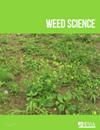Germination Biology of Liverseedgrass (Urochloa panicoides) and its Response to Postemergence Herbicides in Australian Conditions
IF 2.5
2区 农林科学
Q2 AGRONOMY
引用次数: 1
Abstract
Abstract Liverseedgrass (Urochloa panicoides P. Beauv.) is one of the most important summer grass weed species in the eastern cropping system of Australia. Experiments were conducted to evaluate the effects of temperature, salt stress, water stress, burial depth, and sorghum crop residue load on germination and emergence of U. panicoides and the performance of postemergence herbicides on this weed species. The optimal germination temperature regimes for U. panicoides were 30/ 20 and 35/25 C (alternating day/night temperatures), but seeds also germinated at temperatures occurring in winter, spring, and autumn in Australia (15/5, 20/10, and 25/15 C). A concentration of 48 mM sodium chloride and –0.27 MPa osmotic potential inhibited germination of U. panicoides by 50%, indicating that this weed species is not salt and drought tolerant at germination. The maximum germination was obtained for the surface seeds; a burial depth of 1.9 cm inhibited emergence by 50%. No seedlings emerged from the 12-cm depth, but about 3% of seedlings emerged from the 8 cm depth. The addition of sorghum residue amounts up to 8,000 kg ha–1 to the soil surface stimulated U. panicoides' emergence compared with the no-residue treatment, suggesting that conservation agriculture will promote the emergence of U. panicoides. Several postemergence herbicides were found to be effective in controlling this weed species, especially when applied at an early stage. Information obtained from this study will help to develop effective and sustainable control measures for U. panicoides and other weed species with similar germination requirements.澳大利亚条件下苜蓿的发芽生物学及其对出苗后除草剂的反应
摘要Liversedsgrass(Urochloa panicoides P.Beauv.)是澳大利亚东部种植系统中最重要的夏季杂草之一。通过试验,评价了温度、盐胁迫、水分胁迫、埋深和高粱作物残留量对圆锥花序发芽和出苗的影响,以及出苗后除草剂对该杂草的性能。圆锥花序的最佳发芽温度为30/20和35/25摄氏度(昼夜交替温度),但种子也在澳大利亚冬季、春季和秋季的温度下发芽(15/5、20/10和25/15摄氏度)。浓度为48 mM的氯化钠和–0.27 MPa的渗透势抑制了50%的圆锥花序的发芽,表明该杂草在发芽时不耐盐和干旱。表层种子发芽率最高;1.9厘米的埋深抑制了50%的出苗。在12厘米深处没有幼苗出现,但约3%的幼苗从8厘米深处出现。与无渣处理相比,向土壤表面添加高达8000 kg ha–1的高粱渣刺激了圆锥花的出现,这表明保护性农业将促进圆锥花的产生。一些出苗后除草剂被发现能有效控制这种杂草,尤其是在早期使用时。从这项研究中获得的信息将有助于制定有效和可持续的控制措施,以控制圆锥花序和其他具有类似发芽要求的杂草。
本文章由计算机程序翻译,如有差异,请以英文原文为准。
求助全文
约1分钟内获得全文
求助全文
来源期刊

Weed Science
农林科学-农艺学
CiteScore
4.60
自引率
12.00%
发文量
64
审稿时长
12-24 weeks
期刊介绍:
Weed Science publishes original research and scholarship in the form of peer-reviewed articles focused on fundamental research directly related to all aspects of weed science in agricultural systems. Topics for Weed Science include:
- the biology and ecology of weeds in agricultural, forestry, aquatic, turf, recreational, rights-of-way and other settings, genetics of weeds
- herbicide resistance, chemistry, biochemistry, physiology and molecular action of herbicides and plant growth regulators used to manage undesirable vegetation
- ecology of cropping and other agricultural systems as they relate to weed management
- biological and ecological aspects of weed control tools including biological agents, and herbicide resistant crops
- effect of weed management on soil, air and water.
 求助内容:
求助内容: 应助结果提醒方式:
应助结果提醒方式:


